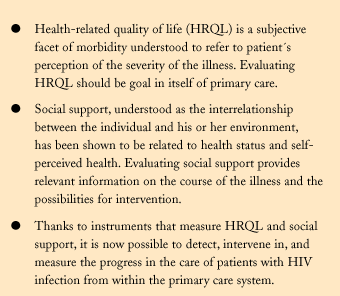Infection by the human immunodeficiency virus (HIV) is a serious public health problem with important health and social implications. As in other chronic diseases characterized by a progressive loss of functional capacity and individual autonomy, the patient´s gradual physical, psychological and social deterioration interfere with his or her lifestyle and diminish self-perceived health. This subjective facet of morbidity--a severe problem from the patient´s point of view--has been defined as health-related quality of life (HRQL).
Evaluating HRQL has become a goal in itself for optimum health care. This task involves obtaining information on the impact of the disease on the patient´s family environment, social relations and self-esteem. In addition, it involves analyzing the efficacy and effectiveness of the
health interventions offered through primary care. There are currently several rapid, simple instruments to measure HRQL--mainly tests and questionnaires--that provide valid, reliable results.
Two types of questionnaire have been used in primary care to measure HRLQ.
Generic questionnaires cover a wide spectrum of factors that influence quality of life, are structured in a manner independent of the clinical diagnosis, and can be used for different populations (i.e., healthy persons or persons with different diseases). A number of these instruments have been validated, including the Sickness Impact Profile, the Nottingham Health Profile and the EuroQoL-5D (EQ-5D); the latter has been adapted validated for Spanish-speaking populations.
Specific questionnaires, in contrast, are designed to evaluate a specific population group, health problem or dimension. Some instruments of this type that have been validated for use in Spanish are functional scales (eg, the Katz, Barthel and Lawton-Brody scales), pain scales (eg, the Questionario del Dolor en Español [Pain Questionnaire in Spanish]), specific questionnaires for chronic diseases (eg, the St. George´s Respiratory Questionnaire, the Parkinson´s Disease Questionnaire [PDQ-39] or the MOS SF-30 for HIV infection), and instruments that measure sociofamilial health (eg, the Duke-UNC-11 and Family APGAR tests).
The MOS-HIV questionnaire has been the most widely used instrument in clinical research to measure HRQL in patients with HIV infection. The development of this instrument was stimulated by the need to evaluate quality of life in patients in whom increasingly limiting symptoms arising from antiviral treatment were appearing sooner than symptoms caused by the disease itself. It is therefore recommended that the MOS questionnaire be administered as soon as possible in patients with HIV infection.
The Duke-UNC-11 is an instrument that makes it possible to evaluate social support quantitatively in two dimensions: confidant support (persons with whom intimate feelings can be talked about) and affective support (persons who express feelings of empathy). Social support, understood as the interrelationship between the individual and his or her environment, has been shown to be related with health status and self-perceived health. Studies in Spain of the relationship between social support and HIV infection have also found a correlation between low social support (as measured with the Duke-UNC-11) and family dysfunction (as measured with the Family APGAR).
The most notable merit of the article that appears in this issue of Atención Primaria is that it confirms, with specific questionnaires that have been shown to be valid and reliable, the direct relationship between low social support and low HRQL score. Another point worthy of emphasis is the bidirectional nature of the mutual influence the authors found between social support and health status in patients with HIV infection. Quantitative and qualitative changes in the social resources available to these patients during the course of their HIV-related illness require complementary studies with more sophisticated instruments than the Duke-UNC-11.
Social and familial factors have a decisive influence on the course of any chronic disease, whether through decompensation, the use of health resources, compliance with treatment or comorbidity due to affective disorders. To the same degree, they also determine self-perceived quality of life.
To the extent to which HIV infection is considered a manageable chronic disease, it will be necessary to detect sociofamilial dysfunctioning and to intervene to enhance those resources that might improve quality of life for these patients. It is now possible to detect, intervene in, and measure progress, from within the primary care system, with simple, rapid, reliable instruments such as those recommended by Remor in this issue.
References
Badia X, Salamero M, Alonso J. La medida de la salud. Guía de escalas de medición en español. Barcelona: Edimac, 1999.
Berraondo I, Iturrioz P. Aplicaciones prácticas de los tests de morbilidad y calidad de vida. En: Guía de Actuación en Atención Primaria. 2.ª ed. Barcelona: semFYC, 2002; p. 1751-6.
Herdman M. La medición de la calidad de vida relacionada con la salud. Med Clin (Barc) 2000;114;22-5.









